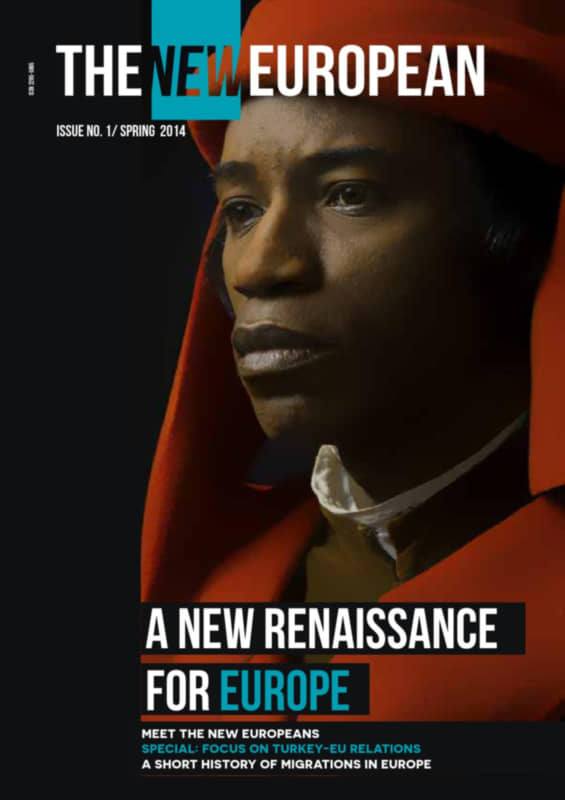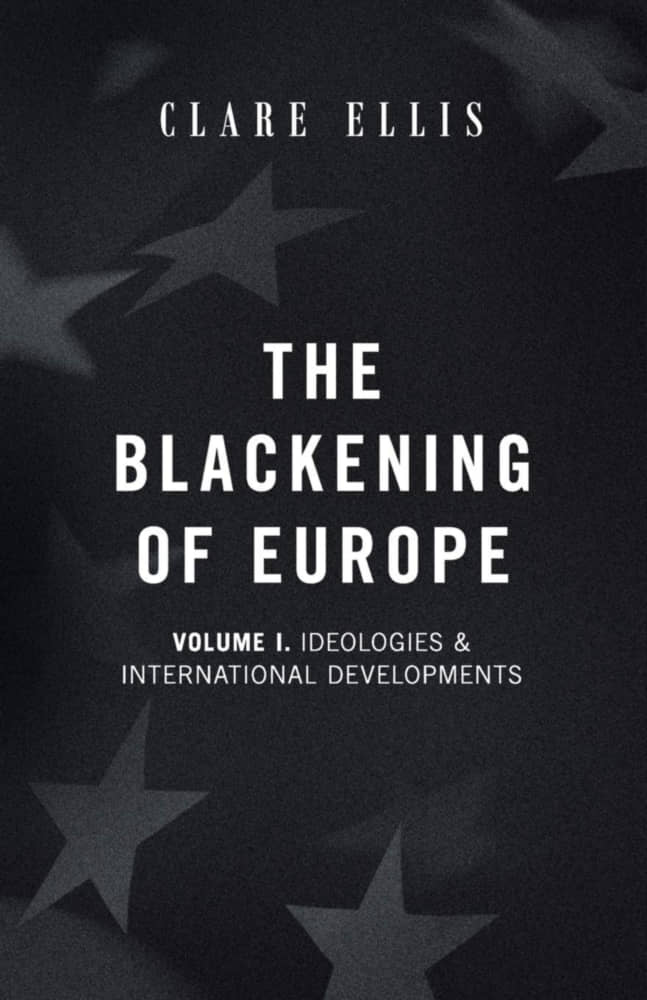Over the course of a mere 60 years Western Europe has been radically transformed demographically, socially and culturally. So extensive are the changes wrought that it is hard to believe they have been executed in less than the lifetime of a single human.
I thought I knew the story of the European Economic Community/EEC, European Union/EU, mass migration, and the dismantling of Europe’s borders. I also thought I knew about the impact of ideologies like liberal-progressivism, Fabianism, multiculturalism, globalization and cultural Marxism. But Clare Ellis’s book showed me how much I did not know. The book, The Blackening of Europe, tracks out the complex story of the ideas, policies and international politics that have led to today’s apparent victory of the cosmopolitan agenda of denationalizing Europeans. [Read an excerpt from this book.]
Ellis (who is no fan of where cosmopolitanism and denationalization have taken Europe) joins the dots between a plethora of players whose ideas have travelled, mutated and connected over time. The result is an intriguing genealogy of ideas and policies which have shaped the journey that Europe has taken. What unfolds is a story guaranteed to infuriate those of us troubled by the damage being inflicted upon Western culture by anti-nationalism, anti-traditionalism, liberal-progressivism, plus the mass migration into Europe of non-culturally proximate peoples. But what an interesting story it is as told by Claire Ellis.
Ellis is a good storyteller who has created a compelling narrative that joins a multiplicity of dots. But, of course, in order to join the dots she had to first tell us about (and flesh-out) each of these dots. And the four key themes in Ellis’ story are denationalisation (and anti-nationalism); the emergence of the EU; the inter-connected ideologies of multiculturalism and immigrationism; and moves to expand the EU’s market by incorporating the Arab world through a Euro-Arab cultural dialogue project.
What becomes clear is that the denationalization of Europe has not been left to chance. European denationalisation (and the EU project) has been (and remains) a deliberate project driven by anti-nationalists. Some of these anti-nationalists have been liberal-cosmopolitans, while others have been socialist-internationalists. Indeed, it is interesting to ponder the nature of the cooperation that grew up between liberals and socialists in their joint promotion of anti-nationalism. It might be argued that this cooperation has amounted to something of a de facto anti-nationalist alliance in post-Second World War Europe.
Even though denationalization has been a world-wide phenomenon, it is worth recognizing the extent to which denationalization assumed an especially organized character in the European context. The politics of anti-nationalism within the EEC (and then the EU) took on the form of a “progressivist” mission. (A mission geared to actively denationalize Europeans and institutionalize a process which aimed to mutate previously separate European nation states into a shared European identity). This mission constituted a form of social engineering on steroids. And it was a variety of progressivist social engineering that would be helped along by deploying mass immigration as a catalyst to speed up social change and identity shifts. Importantly, as Ellis reminds us, this mission of European identity-reconstruction was ideologically driven.
But even if European denationalisation has been a locally organized project, we should not lose sight of the fact that both denationalisation and cultural homogenization are phenomena that transcend local contexts. In this regard, Ellis draws attention to how the EU project was enmeshed with the wider project of globalization. The two ideas of federating Europe and of creating a system of global governance are complementary. Within the ideological dreaming of internationalists and cosmopolitans a federated Europe simply becomes a (regional) federation within a (global) federation. Both serve the same anti-nationalist purpose of first weakening, and then deconstructing, national identities so that new culturally homogenized and hybridized identities can grow in their place. The left of course celebrates the way in which we have slipped into an era of cultural homogenization and hybridization because, for social engineers who see Western culture as something to be challenged, what better way to execute a project of cultural change.
Ellis’ book is a timely reminder that the dream of replacing Europe’s nations with a shared “Europeanism” has long been an agenda pushed by cosmopolitan activists, motivated by an undisguised anti-nationalist agenda. And underpinning this cosmopolitanism was a mainstream media industry that supported globalization. Supporting globalization is a no-brainer for anti-nationalists, given that the globalization project complements the worldview of those David Goodhart has called “anywheres.” The people defined as “anywheres” are those who pride themselves on not being rooted to anywhere, preferring to see themselves as “citizens of the world.” As a consequence, “anywheres” intuitively oppose “somewheres” precisely because “somewheres” are people explicitly rooted in a particular place and who take pride in the national identity which is tied to that specific place.
Ellis unpacks the way in which European cosmopolitans (as “anywheres”) have implicitly understood the synergy between the EU project and the globalization project. Federating Europe can, after all, be seen to serve as a learning-experience or a step on the road to creating a system of global governance. The EU serves as a laboratory in the processes of denationalization; of building a bureaucratized federal system of anywheres-run government; and of learning to manage mass migration as a tool of cultural change (and denationalization).
Elite sanctioned non-European mass migration into Western Europe started 60 years ago. This mass migration has become integral to EU’s cosmopolitan project. For Ellis, a crucial feature of these migratory processes is that they are proving corrosive to the culture of indigenous Europeans. It is no accident that over the past 60 years, we have witnessed European traditional culture being erased at an accelerated rate. And underpinning this elite sanctioned mass migration has been the promotion of two ideologies—multiculturalism and immigrationism.
A fascinating feature of these two ideologies has been high levels of bi-partisanship between socialists and liberals in formulating and running Europe’s mass immigration policies. Thus we saw leftist policy-makers supporting mass migration out of a curious mix of guilt (about imperialism), idealism (associated with the “anywheres” belief in ‘global citizenship’), and a ‘moral’ preference for open borders.
On the other hand, we saw business-aligned policy-makers push for mass migration in order to import labour. Not only did mainstream journalists fail to interrogate these policies and their motivations, but the mainstream media overwhelmingly served as an uncritical propagandist for immigrationism and multiculturalism. While anyone opposing/resisting this immigrationism/multiculturalism faced the likely prospect of being maligned and stigmatized as “racist,” often in the form of a media frenzy. And once this so-called “racism” became criminalized any opposition/ resistance could carry a penalty greater than stigmatization. The outcome was a type of enforced diversification promoted by both human rights legislation and a compliant media that serviced ideologies advocated by the “anywheres.”
But one of the delights of Ellis’ book is that it goes beyond talking about the EU and European migration policies as already discussed by many others. Instead Ellis takes us on a journey which explores the ideas which have fed into and helped underpin the integration and denationalization of Europe: multiculturalism and immigrationism. This includes Fabianism’s influences on Eleanor Roosevelt, John Dewey and the British Labour Party; plus the way the Frankfurt School’s Cultural Marxism fed into pan-European socialism and into broader left-wing thinking about engineering social change.
In unpacking the ideas that have underpinned Europe’s demographic and cultural transformation, Ellis focusses considerable attention on the role of cosmopolitanism in the story of the EU. In particular, we learn of the foundational role played by Count Kalergi and the 1920s Pan-European Movement.
Kalergi was an important European cosmopolitan thinker and a passionate anti-nationalist. Significantly Kalergi advocated the “cleansing” of language and race mixing as vehicles for denationalizing Europe. In this regard, Kalergi can be seen as a pioneer of the sort of ideas that have become embedded into today’s Critical Race Theory. Kalergi’s cosmopolitan dream of erasing Europe’s borders and denationalizing Europeans became foundational for the way the EU has evolved.
The second part of Kalergi’s dream has not yet come to pass—namely creating a new world order based upon a federation of federations. For Kalergi, the EU would be but one of 5 regional (denationalized) federations, which would become the building blocks for a global federation. So, for Kalergi, the integration of Europe was but the first step to building the sort of world government cosmopolitans dream of. But rather than me summarizing Ellis’ work on Kalergi—read the book yourself and see how Kalergi influenced so much European integration planning—such as the Eurafrique project; France’s Constantine Plan; the Strausbourg plan; the Schuman Plan; the EEC; and the EU’s contemporary border and refugee policies.
One of the other areas discussed by Ellis, which makes her book a gem, is the issue of Islamic mass migration into Western Europe, which has been facilitated by the growing influence of cosmopolitan “anywheres” within Europe’s elite circles. There has long been Islamic migration into Europe; but mass immigration is new. Ellis traces this phenomenon back to 1973 when Willy Brandt called an EEC meeting to discuss improving European-Arab relations. This led to the formal launch of the Euro-Arab Dialogue (EAD) in 1974, which institutionalized a mechanism to bring the Arab world and Europe together.
The EAD saw Arab states promise oil and markets in return for Arab migration into Europe. Importantly, Arab participants in EAD said European states needed to make these Arab migrants feel comfortable in Europe, by allowing them to retain their cultural and religious practices in Europe. The resultant 1979 Damascus declaration facilitated mass Arab migration and so initiated what has become a process of Arabizing/Islamisizing Europe. This process was widened by the creation of the Institute for Research on Mediterranean and Euro-Arab corporation in 1995, which has the agenda of bringing the Arab and European cultures together so as to complement the building of one huge integrated economy/ market which some have called Eurabia. The creation of the Anna Lindh Foundation for the Dialogue of Cultures in 2004 deepened this Euro-Arab project further. Unsurprisingly, the growing momentum of the EAD process led to Nicolas Sarkozy putting France’s Eurafrique project back on the agenda in 2007, all of which further hastened the demographic and cultural transformation of France (and Europe).
For those interested in Europe’s demographic and cultural transformation, read Ellis’ book. You’ll finish it with many new insights into a range of ideas, theories and projects which contributed to the way in which multiculturalism, immigrationism, denationalization and anywhereism have become so influential.
Eric Louw has a career spanning universities in both South Africa and Australia. He has published extensively in the fields of political communication and South African political discourses. His books include, The Rise, Fall and Legacy of Apartheid; Roots of the Pax Americana; and The Media and Political Process.
Featured image: New European Magazine, March 2014.

